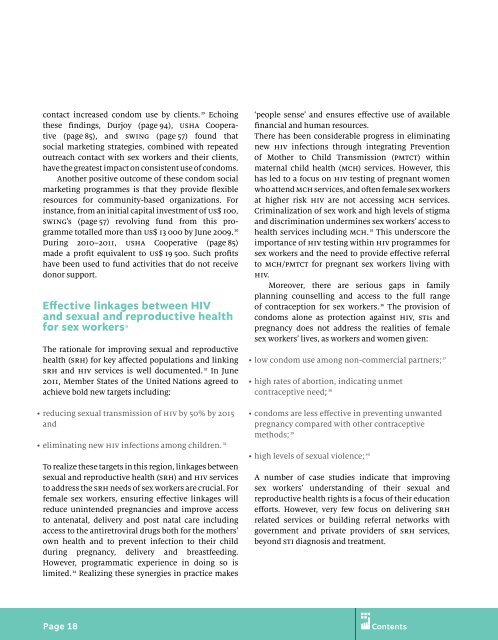The HIV and Sex Work Collection - Joint Programme Monitoring ...
The HIV and Sex Work Collection - Joint Programme Monitoring ...
The HIV and Sex Work Collection - Joint Programme Monitoring ...
You also want an ePaper? Increase the reach of your titles
YUMPU automatically turns print PDFs into web optimized ePapers that Google loves.
contact increased condom use by clients. 29 Echoingthese findings, Durjoy (page 94), USHA Cooperative(page 85), <strong>and</strong> SWING (page 57) found thatsocial marketing strategies, combined with repeatedoutreach contact with sex workers <strong>and</strong> their clients,have the greatest impact on consistent use of condoms.Another positive outcome of these condom socialmarketing programmes is that they provide flexibleresources for community-based organizations. Forinstance, from an initial capital investment of US$ 100,SWING’s (page 57) revolving fund from this programmetotalled more than US$ 13 000 by June 2009. 30During 2010–2011, USHA Cooperative (page 85)made a profit equivalent to US$ 19 500. Such profitshave been used to fund activities that do not receivedonor support.Effective linkages between <strong>HIV</strong><strong>and</strong> sexual <strong>and</strong> reproductive healthfor sex workers 31<strong>The</strong> rationale for improving sexual <strong>and</strong> reproductivehealth (SRH) for key affected populations <strong>and</strong> linkingSRH <strong>and</strong> <strong>HIV</strong> services is well documented. 32 In June2011, Member States of the United Nations agreed toachieve bold new targets including:• reducing sexual transmission of <strong>HIV</strong> by 50% by 2015<strong>and</strong>• eliminating new <strong>HIV</strong> infections among children. 33To realize these targets in this region, linkages betweensexual <strong>and</strong> reproductive health (SRH) <strong>and</strong> <strong>HIV</strong> servicesto address the SRH needs of sex workers are crucial. Forfemale sex workers, ensuring effective linkages willreduce unintended pregnancies <strong>and</strong> improve accessto antenatal, delivery <strong>and</strong> post natal care includingaccess to the antiretroviral drugs both for the mothers’own health <strong>and</strong> to prevent infection to their childduring pregnancy, delivery <strong>and</strong> breastfeeding.However, programmatic experience in doing so islimited. 34 Realizing these synergies in practice makes‘people sense’ <strong>and</strong> ensures effective use of availablefinancial <strong>and</strong> human resources.<strong>The</strong>re has been considerable progress in eliminatingnew <strong>HIV</strong> infections through integrating Preventionof Mother to Child Transmission (PMTCT) withinmaternal child health (MCH) services. However, thishas led to a focus on <strong>HIV</strong> testing of pregnant womenwho attend MCH services, <strong>and</strong> often female sex workersat higher risk <strong>HIV</strong> are not accessing MCH services.Criminalization of sex work <strong>and</strong> high levels of stigma<strong>and</strong> discrimination undermines sex workers’ access tohealth services including MCH. 35 This underscore theimportance of <strong>HIV</strong> testing within <strong>HIV</strong> programmes forsex workers <strong>and</strong> the need to provide effective referralto MCH/PMTCT for pregnant sex workers living with<strong>HIV</strong>.Moreover, there are serious gaps in familyplanning counselling <strong>and</strong> access to the full rangeof contraception for sex workers. 36 <strong>The</strong> provision ofcondoms alone as protection against <strong>HIV</strong>, STIs <strong>and</strong>pregnancy does not address the realities of femalesex workers’ lives, as workers <strong>and</strong> women given:• low condom use among non-commercial partners; 37• high rates of abortion, indicating unmetcontraceptive need; 38• condoms are less effective in preventing unwantedpregnancy compared with other contraceptivemethods; 39• high levels of sexual violence; 40A number of case studies indicate that improvingsex workers’ underst<strong>and</strong>ing of their sexual <strong>and</strong>reproductive health rights is a focus of their educationefforts. However, very few focus on delivering SRHrelated services or building referral networks withgovernment <strong>and</strong> private providers of SRH services,beyond STI diagnosis <strong>and</strong> treatment.Page 18
















